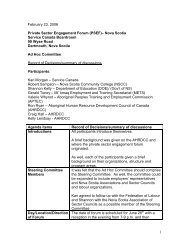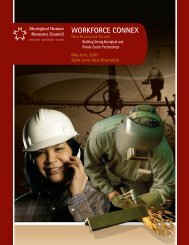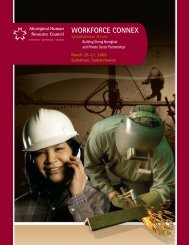Labrador - Aboriginal Human Resource Council
Labrador - Aboriginal Human Resource Council
Labrador - Aboriginal Human Resource Council
You also want an ePaper? Increase the reach of your titles
YUMPU automatically turns print PDFs into web optimized ePapers that Google loves.
The Discussion<br />
Participants engaged in discussion on how to<br />
increase <strong>Aboriginal</strong> participation in overall<br />
employment, with a focus on trades and<br />
apprenticeship in the <strong>Labrador</strong> region.<br />
The dialogue and deliberations at the session<br />
are contained below.<br />
PART 1:<br />
PRESENTATIONS<br />
A number of presentations were made to provide<br />
the participants with context for their discussions.<br />
The presentations included:<br />
• <strong>Labrador</strong> Market Overview, Rex Goudie,<br />
Atlantic Canada Opportunities Agency<br />
(ACOA)<br />
• Statistical Overview of the <strong>Labrador</strong> Labour<br />
Market, Pam Toope, Department of <strong>Human</strong><br />
<strong>Resource</strong>s, Labour and Employment (HRLE).<br />
PART 2:<br />
PANEL<br />
over the past three-years and sees this<br />
partnership continuing in the future.<br />
• Catherine Taplin, Iron Ore Company of<br />
Canada (IOCC). Iron Ore has 1,600<br />
employees and two-thirds of staff will be<br />
retiring over the next five years. For Iron<br />
Ore, retention and recruitment has been,<br />
and will continue to be, a challenge.<br />
• Ameila Moss, Servco 198. Servco 198 has<br />
350–360 employees working in a unionized<br />
environment. The company’s main issues are<br />
recruitment and retention. Within five years,<br />
one-third of their workforce will retire.<br />
• David Hollett, HL O’Connell. The<br />
construction company employs a number<br />
of <strong>Aboriginal</strong> people and their experience<br />
in <strong>Labrador</strong> has been very positive. More<br />
has to be done to promote the trades as a<br />
career. The Joint Employment and Training<br />
Initiative is a good program since it<br />
has produced a number of skilled<br />
<strong>Aboriginal</strong> workers.<br />
PART 3:<br />
DEMAND SIDE<br />
A panel of private sector company representatives<br />
presented a short synopsis of their demand side<br />
issues and answered questions from the plenary.<br />
Following is a list of panelists and a short synopsis<br />
of their presentation:<br />
• Tom Paddon, Voisey’s Bay Nickel Company<br />
Ltd (VBNC). Over the next 10 years there<br />
will be 80,000 vacancies in the mining<br />
sector. Voisey’s Bay values the benefit<br />
of linking with <strong>Aboriginal</strong> people. The<br />
company has built a very productive<br />
relationship with <strong>Aboriginal</strong> Peoples<br />
Purpose<br />
This was a general discussion on the demand side<br />
(employer) of the employment equation. Business<br />
was setup as advisors to help AHRDAs increase<br />
their understanding of the demand side.<br />
The following is a very brief summary of highlights<br />
that outline concerns and issues that were taken<br />
from the various reports and conversations about<br />
the demand side of the labour market equation:<br />
5









